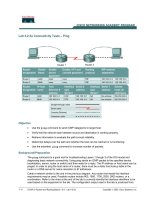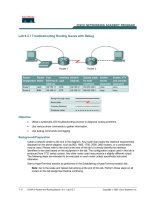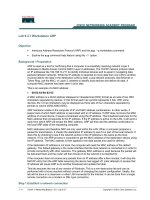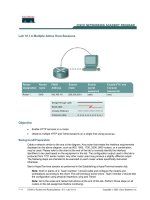Tài liệu Lab 10.3.5a Basic Subnetting docx
Bạn đang xem bản rút gọn của tài liệu. Xem và tải ngay bản đầy đủ của tài liệu tại đây (227.8 KB, 7 trang )
Lab 10.3.5a Basic Subnetting
Objective
• How to identify reasons to use a subnet mask
• How to distinguish between a default subnet mask and a custom subnet mask
• What given requirements determine the subnet mask, number of subnets, and hosts per subnet
• What needs to be understood about useable subnets and useable numbers of hosts
• How to use the ANDing process to determine if a destination IP address is local or remote
• How to identify valid and invalid IP host addresses based on a network number and subnet mask
Background / Preparation
This lab exercise focuses on the basics of IP subnet masks and their use with TCP/IP networks. The
subnet mask can be used to split up an existing network into subnetworks, or subnets. Some of the
primary reasons for subnetting are the following:
• Reduce the size of the broadcast domains, which creates smaller networks with less traffic
• Allow LANs in different geographical locations to communicate through routers
• Provide improved security by separating one LAN from another
Routers separate subnets, and determine when a packet can go from one subnet to another. Each
router a packet goes through is considered a hop. Subnet masks help workstations, servers, and
routers in an IP network determine if the destination host for the packet they want to send is on their
own network or another network. This lab reviews the default subnet mask and then focuses on
custom subnet masks. Custom subnet masks use more bits than the default subnet masks by
borrowing these bits from the host portion of the IP address. This creates a three-part address:
• The original network address
• The subnet address made up of the bits borrowed
• The host address made up of the bits left after borrowing some for subnets
Step 1 Review the structure of IP addresses
If an organization has a Class A IP network address, the first octet, or 8 bits, is assigned and does
not change. The organization can use the remaining 24 bits to define up to 16,777,214 hosts on its
network. This is a lot of hosts. It is not possible to put all of these hosts on one physical network
without separating them with routers and subnets.
It is common for a workstation to be on one network or subnet and a server to be on another. When
the workstation needs to retrieve a file from the server it will need to use its subnet mask to
determine the network or subnet that the server is on. The purpose of a subnet mask is to help hosts
and routers determine the network location where a destination host can be found. Refer to the table
below to review the following information:
• The IP address classes
• The default subnet masks
1 - 7 CCNA 1: Networking Basics v 3.0 – Lab10.3.5a Copyright 2003, Cisco Systems, Inc.
• The number of networks that can be created with each class of network address
• The number of hosts that can be created with each class of network address
Address
Class
1
st
Octet
Decimal
Range
1
st
Octet
High
Order Bits
Network/Host ID
(N=Network,
H=Host)
Default
Subnet Mask
Number
of
Networks
Hosts per
Network
(Usable
Addresses)
A
1 – 126 * 0 N.H.H.H 255.0.0.0 126 (2
7
–
2)
16,777,214
(2
24
– 2)
B
128 – 191 10 N.N.H.H 255.255.0.0 16,382
(2
14
– 2)
65,534
(2
16
– 2)
C
192 – 223 110 N.N.N.H 255.255.255.0 2,097,150
(2
21
– 2)
254 (2
8
– 2)
D
224 – 239 1110 Reserved for Multicasting
E
240 – 254 11110 Experimental; used for research
* Class A address 127 cannot be used and is reserved for loopback and diagnostic functions.
Step 2 Review the ANDing process
Hosts and routers use the ANDing process to determine if a destination host is on the same network
or not. The ANDing process is done each time a host wants to send a packet to another host on an
IP network. In order to connect to a server, the IP address of the server or the host name, such as,
, must be known. If the host name is used a Domain Name Server (DNS) will
convert it to an IP address.
First, the source host will compare, or AND, its own IP address to its own subnet mask. The result of
the ANDing is to identify the network where the source host resides. It will then compare the
destination IP address to its own subnet mask. The result of the 2
nd
ANDing will be the network that
the destination host is on. If the source network address and the destination network address are the
same, they can communicate directly. If the results are different, they are on different networks or
subnets. If this is the case, the source host and the destination host will need to communicate
through routers or might not be able to communicate at all.
ANDing depends on the subnet mask. Subnet masks are always all ones. A default subnet mask for
a Class C network is 255.255.255.0 or 11111111.111111111.111111111.00000000. This is
compared to the source IP address bit for bit. The first bit of the IP address is compared to the first
bit of the subnet mask, the second bit to the second, and so on. If the two bits are both ones, the
ANDing result is a one. If the two bits are a zero and a one, or two zeros, the ANDing result is a zero.
Basically, this means that a combination of 2 ones results in a one, anything else is a zero. The
result of the ANDing process is the identification of the network or subnet number that the source or
destination address is on.
Step 3 Two Class C networks using the default subnet mask
This example shows how a Class C default subnet mask can be used to determine which network a
host is on. A default subnet mask does not break an address into subnets. If the default subnet mask
is used, the network is not being subnetted. Host X, the source on network 200.1.1.0 has an IP
address of 200.1.1.5. It wants to send a packet to Host Z, the destination on network 200.1.2.0 and
has an IP address of 200.1.2.8. All hosts on each network are connected to hubs or switches and
2 - 7 CCNA 1: Networking Basics v 3.0 – Lab10.3.5a Copyright 2003, Cisco Systems, Inc.
then to a router. Remember that with a Class C network address, the first 3 octets, or 24 bits, are
assigned as the network address. So, these are two different Class C networks. This leaves one
octet, or 8 bits for hosts, so each Class C network could have up to 254 hosts:
• 2
8
= 256 – 2 = 254
Source net: 200.1.1.0 Destination net: 200.1.2.0
Subnet mask: 255.255.255.0 Subnet mask: 255.255.255.0
Host IP 200.1.1.5 Host 200.1.2.8
Hub
Hub
Router
Host
Z
Host
X
Router interface Router interface
IP 200.1.1.1 IP 200.1.2.1
The ANDing process helps the packet get from Host 200.1.1.5 on network 200.1.1.0 to Host
200.1.2.8 on network 200.1.2.0 by using the following steps:
1. Host X compares its own IP address to its own subnet mask using the ANDing process.
Host X IP address 200.1.1.5 11001000.00000001.00000001.00000101
Subnet Mask 255.255.255.0 11111111.11111111.11111111.00000000
ANDing Result (200.1.1.0) 11001000.00000001.00000001.00000000
Note: The result of the ANDing process is the network address of Host X, which is 200.1.1.0.
2. Next, Host X compares the IP address of the Host Z destination to its own subnet mask using
the ANDing process.
Host Z IP address 200.1.2.8 11001000.00000001.00000010.00001000
Subnet Mask 255.255.255.0 11111111.11111111.11111111.00000000
ANDing Result (200.1.2.0) 11001000.00000001.00000010.00000000
Note: The result of the ANDing process is the network address of Host Z, which is 200.1.2.0.
Host X compares the ANDing results from Step 1 and the ANDing results from Step 2, and notes
they are different. Host X now knows that Host Z is not in its local-area network (LAN). Therefore, it
must send the packet to its default gateway, which is the IP address of the router interface of
200.1.1.1 on network 200.1.1.0. The router then repeats the ANDing process to determine which
router interface to send the packet out to.
3 - 7 CCNA 1: Networking Basics v 3.0 – Lab10.3.5a Copyright 2003, Cisco Systems, Inc.
Step 4 One Class C network with subnets using a custom subnet mask
This example uses a single Class C network address (200.1.1.0) and shows how a Class C custom
subnet mask can be used to determine which subnetwork (or subnet) a host is on and to route
packets from one subnetwork to another. Remember that with a Class C network address, the first 3
octets, or 24 bits are assigned as the network address. This leaves one octet, or 8 bits, for hosts.
So, each Class C network could have up to 254 hosts:
• 2
8
= 256 – 2 = 254
Perhaps less than 254 hosts, workstations and servers combined, are desired on one network. This
could be for security reasons or to reduce traffic. It can be done by creating two subnetworks and
separating them with a router. This will create smaller independent broadcast domains and can
improve network performance and increase security. This is possible because these subnetworks
will be separated by one or more router. Assume at least two subnetworks will be needed and that
there will be at least 50 hosts per subnetwork. Because there is only one Class C network address,
only 8 bits in the fourth octet are available for a total of 254 possible hosts. Therefore, a custom
subnet mask must be created. The custom subnet mask will be used to borrow bits from the host
portion of the address. The following steps help accomplish this:
1. The first step to subnetting is to determine how many subnets are needed. In this case, its two
subnetworks. To see how many bits should be borrowed from the host portion of the network
address, add the bit values from right to left until the total is equal to or greater than the number
of subnets needed. Because two subnets are needed, add the one bit and the two bit, which
equals three. This is greater than the number of subnets needed. To remedy this, borrow at least
two bits from the host address starting from the left side of the octet that contains the host
address.
Network address: 200.1.1.0
4
th
octet Host address bits: 1 1 1 1 1 1 1 1
Host address bit values 128 64 32 16 8 4 2
1
(
from right)
Add bits starting from the right side, the 1 and the 2, until the sum is greater than the number of
subnets needed.
Note: An alternate way to calculate the number bits to be borrowed for subnets is to take the
number of bits borrowed to the power of 2. The result must be greater than the number of
subnets needed. As an example if 2 bits are borrowed the calculation is two to the second
power, which equals four. Since the number of subnets needed is two this should be
adequate.
2. After we know how many bits to borrow, we take them from the left side of the of the host
address, the 4
th
octet. Every bit borrowed from the host address bit leaves fewer bits for the
hosts. Even though the number of subnets is increased, the number of hosts per subnet is
decreased. Because two bits need to be borrowed from the left side, that new value must be
shown in the subnet mask. The existing default subnet mask was 255.255.255.0 and the new
custom subnet mask is 255.255.255.192. The 192 results from adding the first two bits from the
left, 128 + 64 = 192. These bits now become 1s and are part of the overall subnet mask. This
leaves 6 bits for host IP addresses or 2
6
= 64 hosts per subnet.
4
th
Octet borrowed bits for subnet: 1 1 0 0 0 0 0 0
Subnet bit values: (from left side) 128
64 32 16 8 4 2 1
With this information, the following table can be built. The first two bits are the subnet binary value.
The last 6 bits are the host bits. By borrowing 2 bits from the 8 bits of the host address 4 subnets,
2^2, with 64 hosts each, can be created. The 4 networks created are as follows:
4 - 7 CCNA 1: Networking Basics v 3.0 – Lab10.3.5a Copyright 2003, Cisco Systems, Inc.
The 200.1.1.0 network
The 200.1.1.64 network
The 200.1.1.128 network
The 200.1.1.192 network
The 200.1.1.0 network is considered unusable, unlesss the networking device supports the IOS
command ip subnet-zero, which allows using the first subnet.
Subnet No. Subnet Bits
Borrowed
Binary Value
Subnet Bits
Decimal
Value
Host Bits Possible
Binary Values (Range)
(6 Bits)
Subnet/Host
Decimal
Range
Useable?
0 Subnet 00 0 000000–111111 0–63 No
1
st
Subnet 01 64 000000–111111 64–127 Yes
2
nd
Subnet 10 128 000000–111111 128–191 Yes
3
rd
Subnet 11 192 000000–111111 192–254 No
Notice that the first subnet always starts at 0 and, in this case, increases by 64, which is the number
of hosts on each subnet. One way to determine the number of hosts on each subnet or the start of
each subnet is to take the remaining host bits to the power of 2. Because we borrowed two of the 8
bits for subnets and have 6 bits left, the number of hosts per subnet is 2
6
or 64. Another way to figure
the number of hosts per subnet or the increment from one subnet to the next is to subtract the
subnet mask value in decimal, 192 in the fourth octet, from 256, which is the maximum number of
possible combinations of 8 bits. This equals 64. This means start at 0 for the first network and add 64
for each additional subnetwork. For example, if the second subnet is used, the 200.1.1.64 network
cannot be used for a host ID since the network ID of the 64 subnet has all zeros in the host portion.
Another common way to represent a subnet mask, is the use of the “slash/number” (/#) where the #
following the slash is the number of bits used in the mask (network and subnet combined). As an
example, a Class C network address such as 200.1.1.0 with a standard subnet mask
(255.255.255.0) would be written as 200.1.1.0 /24, indicating that 24 bits are used for the mask. The
same network, when subnetted by using two host bits for subnets, would be written as 200.1.1.0 /26.
This indicates that 24 bits are used for the network and 2 bits for the subnet. This would represent a
custom subnet mask of 255.255.255.192 in dotted decimal format.
A Class A network of 10.0.0.0 with a standard mask (255.0.0.0) would be written as 10.0.0.0 /8. If 8
bits (the next octet) were being used for subnets it would be written as 10.0.0.0 /16. This would
represent a custom subnet mask of 255.255.0.0 in dotted decimal format. The “slash” number after
the network number is an abbreviated method of indicating the subnet mask being used.
Step 5 Use the following information and the previous examples to answer the following
subnet-related questions
A company has applied for and received a Class C network address of 197.15.22.0. The physical
network is to be divided into 4 subnets, which will be interconnected by routers. At least 25 hosts will
be needed per subnet. A Class C custom subnet mask needs to be used and a router is needed
between the subnets to route packets from one subnet to another. Determine the number of bits that
need to be borrowed from the host portion of the network address and the number of bits that will be
left for host addresses.
Note: There will be 8 possible subnets, of which 6 can be used.
Fill in the following table and answer the following questions:
5 - 7 CCNA 1: Networking Basics v 3.0 – Lab10.3.5a Copyright 2003, Cisco Systems, Inc.









